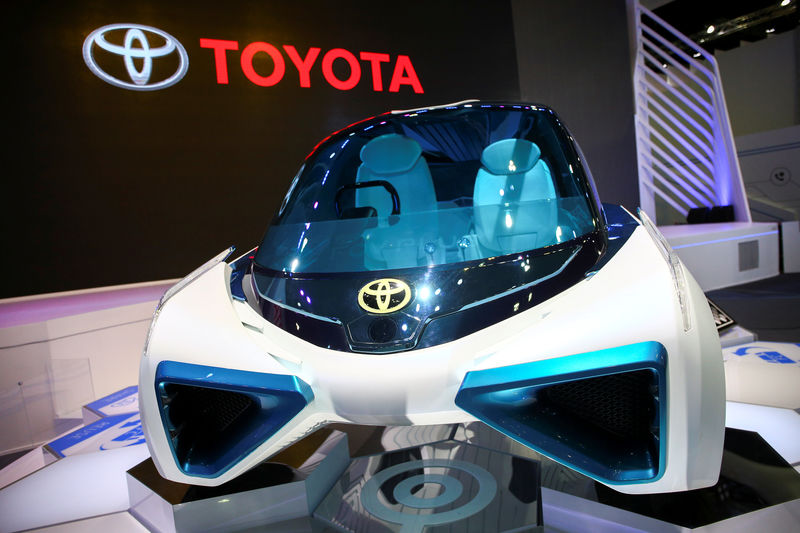By Barbara Lewis
LONDON (Reuters) - Anglo American (L:AAL) is placing a contrarian bet on hydrogen fuel cell vehicles as it tries to squeeze more profit from its platinum reserves, but risks being left behind as rival miners look to cash in on battery-powered cars.
A push, particularly in Europe and China, for lower-emission transport raises the prospect of weaker demand for platinum, whose biggest industrial use is in diesel vehicles.
Other big miners are positioning themselves for the shift away from the combustion engine by betting on lithium and cobalt, both used in electric vehicle batteries.
Glencore (L:GLEN) signed a major deal last October to sell 20,000 tonnes of cobalt products, a hitherto niche material whose production it dominates, while Rio Tinto (AX:RIO) (L:RIO) is sitting on a large deposit of lithium.
As the world's top supplier of platinum, Anglo American is left with little choice but to remain committed to the metal. But it sees strength in what others may perceive as a weakness.
"Platinum and palladium will long play a critical air quality role in the global vehicle fleet, including in heavy commercial vehicles, hybrids and the emerging hydrogen fuel cell electric technology," CEO Mark Cutifani told Reuters.
The firm has modernised operations, aiming to mechanise at least 70 percent of its platinum mining to boost efficiency. Cutifani is relentlessly pursuing a target of 15 percent return on capital, up from 4 percent in the first half of this year.
It has also invested $110 million on encouraging technologies that use platinum, setting up partnerships with innovators, and lobbying governments to provide more infrastructure for hydrogen fuel cell vehicles.
Instead of relying on a battery, such vehicles convert hydrogen into electricity using a fuel cell, in which platinum acts as a catalyst. Water is the only emission.
Each vehicle would need between 10-15 grams of platinum, Anglo estimates, compared with around 7 grams in the catalytic converters of an average diesel car.
WILL THE BET PAY OFF?
China has set a target of 1 million hydrogen fuel cell vehicles by 2030, which Anglo says would require 300,000 troy ounces of platinum, about 10 percent of current auto demand and a chunk of its annual production of more than 2 million ounces.
But so far the take-up of hydrogen vehicles is tiny, and industry experts say their wider use is years away at best, with high purchase prices and a lack of refuelling stations the major barriers.
Anglo says its lobbying is nonetheless paying off.
Britain, for example, announced a 23 million pound fund to accelerate the take-up of hydrogen vehicles and has pledged to expand the refuelling network from a dozen stations nationwide so far.
Cutifani meanwhile joined forces with CEOs from the motor, chemical and oil industries who launched the Hydrogen Council lobbying group at the start of this year.
Toyota (T:7302), which backs fuel cells because it does not want to be dependent on a single technology, was among those represented. The Japanese car maker sees advantages in hydrogen vehicles' greater range and faster refuelling compared with battery power, although it has said it expects the technology to reach the mainstream only by the mid-to-late 2020s.
It is also seeking to reduce the amount of platinum needed to keep down costs.
Volumes of platinum used in fuel cells per car have been falling for the last 10 years, Toyota's director of advanced technologies Craig Scott told Reuters, and are likely to drop further through technology or the use of alternative metals.
BOTTOM LINE
At the height of the platinum market around a decade ago, when prices soared above $2,000 an ounce, the metal accounted for nearly 30 percent of Anglo's core earnings (EBITDA).
That share has fallen to less than 10 percent as the price of platinum has dropped to around $980 an ounce
Cutifani said there were no plans to expand the platinum business. But it is a significant contributor to earnings that could boost shareholder returns in the event of a platinum rally.
That may be a long wait.
Frances Hudson, an investment director at Aberdeen Standard, which holds Anglo American shares, said the short-term consensus was for weak prices for most of the commodities the firm holds.
"But the company's portfolio of long-life and mainly low cost assets (diamonds, copper and platinum) should be fine on a three-to-five year outlook as supplies tighten," she said.
Anglo is focussed in the meantime on raising the value of every ounce of platinum it mines. Investors are waiting to see whether it is a bet that pays off.
"The market believes in electric vehicles. The market is sceptical about fuel cells. Anglo could be right, but the market has yet to be convinced," said Chris LaFemina, a managing director specialised in mining at Jefferies bank.
For graphic on Anglo versus peers, platinum price, click -
For graphic on fuell cell vehicles, click - http://tmsnrt.rs/2wVJerr

For graphic on mining production, click - http://tmsnrt.rs/2uWRQg2